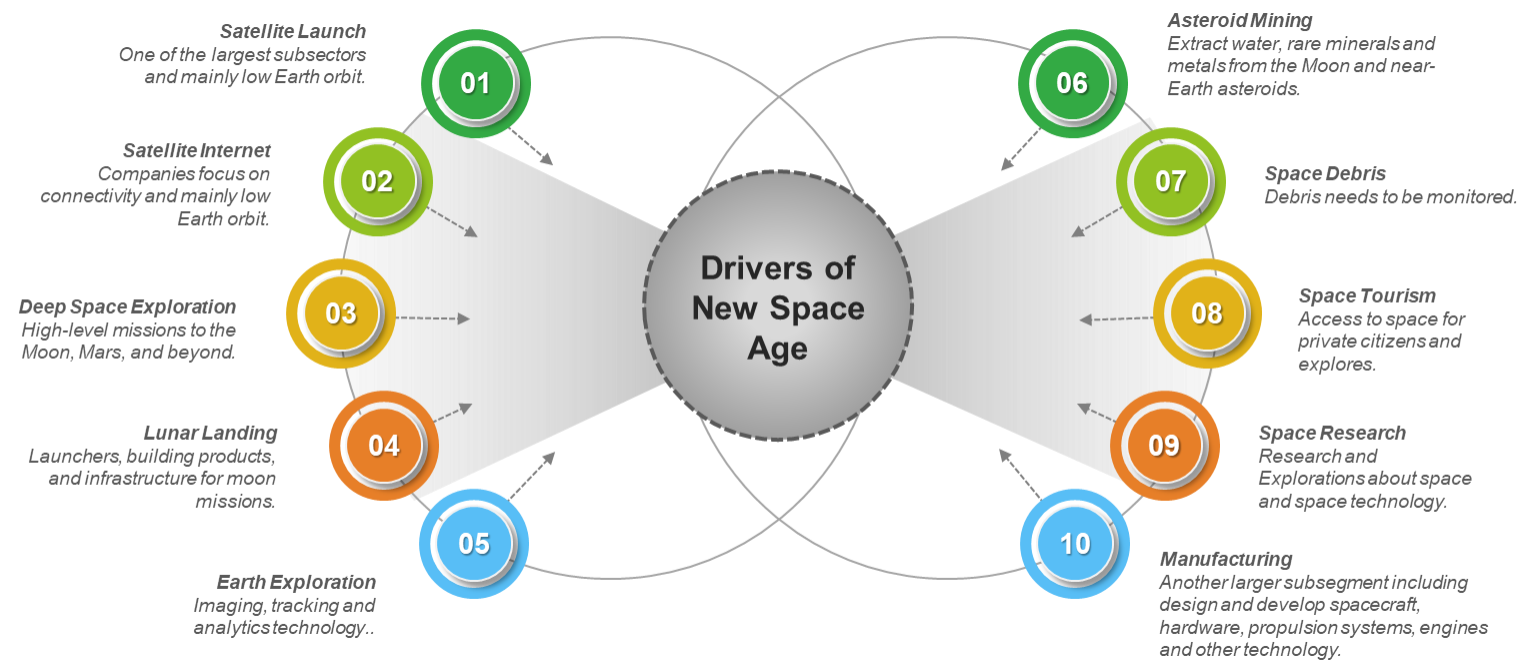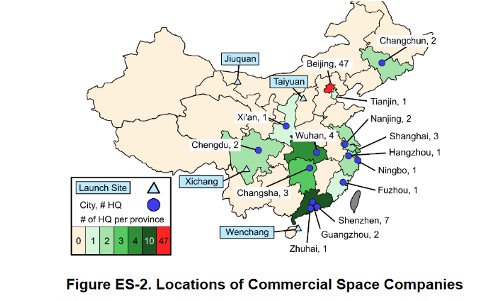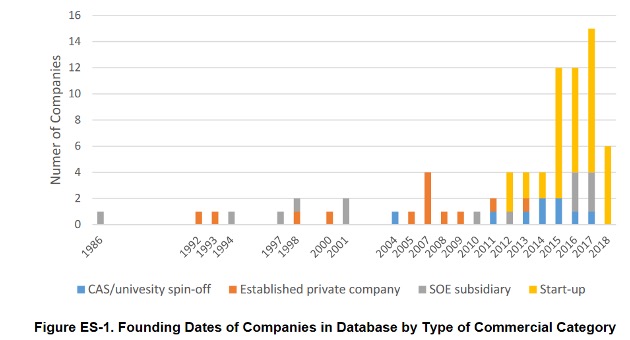Global Space Age
Executive Summary
We decided to focus our thematic on space-to-space ecosystem. SpaceX commoditized the low-orbit economy driving the satellite sector. The only sub-activities in low-orbital economy interesting us must be focused on commercial cargo and crew flights, and satellite manufacturers able to evolve their business into deep-space technology.

The “Journey to Mars” is the main driver of all the new space exploration age. This race will fuel important milestones: Space stations will be more numerous and gigantic; a permanent base on the Moon will be established; robots and Drones will be massively sent to Mars.
The 10 Key drivers of the new space age will calibrate our thematic. We don’t consider Satellite Internet (including geolocation) as a key driver of real space exploration and new space-to-space ecosystem.

Perimeters of the Space Economy
If we are more focused on space-to-space activities, we found it interesting to integrate the perimeters of the space economy proposed by the OECD.
The turnover of the global space economy reached $423.8bn, including $271bn from the satellite industry.
- Space-derived activities in other sectors
New activities in various economic sectors that derive from or have relied on space technology transfers. - Downstream space sector
Daily operations of space infrastructure and “down-to-earth” activities directly relying on the provision of space capacity. - Upstream space sector
Scientific and technological foundations of space programs, manufacturing and production of space infrastructures.
The 10 main Segments of the New Space Age
The greatest challenge is to find listed companies (less than 15%), while a Space-based economy will be the future.
- Satellite Launchers
- Propulsion Manufacturers
- Research Craft & Tech Demonstrators
- Landers, Rovers & Orbiters
- Cargo & Crew Transport Vehicles
- Launch Vehicle Manufacturers
- Spaceliner Companies
- Spacecraft Component Developers & Manufacturers
- Space-based economy
Space Manufacturing, Space Mining, Space Stations & Space Settlement
The most Important Space Programs to Come
- First drone flight on Mars.
- Engaged Space tourism (Blue Origin, Roscomos & Space Adventures).
- China start to build its first space station.
2022
Globalization & Mars
- India will send the first group of Indian astronauts.
- SpaceX plans to launch an unmanned mission to Mars.
- China plans to begin fully operating its third space station, to put astronauts in a lunar base later in that decade.
2023
Asteroids, the Moon & Mars
- The European Hera Mission will be the first human visit to a binary asteroid system.
- SpaceX’s first Moon tourism trip.
- The Osiris-Rex mission will take samples of this asteroid.
- NASA’s VIPER rover launches to the Moon’s south pole to study water ice.
2024
The Moon & Phobos
- The Artemis mission will take astronauts to the Lunar South Pole to learn more about the availability of resources such as water and test vital technology.
- Japan’s Martian Moons eXploration mission launches to collect samples of Phobos.
2025
Phobos & The Moon
- JAXA’s Martian Moons Exploration probe will enter Mars orbit before moving on the Phobos to collect particles.
- US Space Station in orbit around the Moon.
- NASA’s Solar Cruiser will use a large solar sail to create an artificial orbit between the Earth and Sun.
2026
Asteroid & Titan
- Psyche, one of the 10 major asteroids in the asteroid belt which scientists will be visited.
- The rotorcraft is scheduled to launch and is expected to arrive at Titan in 2034.
2029+
Mars, Mars & Mars
- NASA is aiming to send people to Mars by 2030 (at the earliest).
Space-to-space sectors are the future
The “why” of any investment is one of three main value of GATE Advisory. As depicted the previous slide : time, infrastructures, and mining seem to be the focus of space exploration for this decade and beyond.
- Fission thermal rockets : Nuclear fission rockets have never been flown in space, but they have been tested on the ground. They should be able to shorten flight times between Earth and Mars from some seven months to about three months for future crewed missions.
- Electric Propulsion : While slow, ion drives are among the most fuel-efficient of all spacecraft propulsion methods, so could get us further. Nasa is currently developing a high-power electric propulsion system for the Lunar Gateway, an outpost which will orbit the Moon.
- Solar sails : As the energies of individual photons are very small, an extremely large sail size is needed for any appreciable acceleration. The speed gain will also depend on how far from the Sun you are. At Earth, the power received from sunlight is about 1.3 kW per square meter.
- Space systems Engineering
- Ground Segment Operations
- Mission Operations
- Spaceports
- Space Security, including infrastructure, missions, and applications, but also cybersecurity.
Made In Space, Inc. has been at the forefront of manufacturing “in space, for space” since 2014, when it 3D-printed a wrench onboard the ISS. Today, the company is exploring other products, such as high-quality fiber-optic cable, that terrestrial customers may be willing to pay to have manufactured in zero-gravity. But the company also recently received a $74 million contract to 3D-print large metal beams in space for use on NASA spacecraft, and future private-sector spacecraft will certainly have similar manufacturing needs which 3D Printing companies hope to be well-positioned to fulfill.
Another major area of space-for-space investment is in building and operating space infrastructures such as habitats, laboratories, and factories. For example, in February 2020, Maxar Technologies was awarded a $142m contract from NASA to develop a robotic construction tool that would be assembled in space for use on low-Earth orbit spacecraft.
The “why” of any investment is one of the three main values of GATE Advisory. As depicted in the previous slide : time, infrastructures, and mining seem to be the focus of space exploration for this decade and beyond.
Space mining, or asteroid mining, refers to the mining of asteroids and other minor planets for their valuable raw materials. While space mining has not yet become a reality, the technology that will eventually enable to the exploitation of the rich resources of the asteroids in the solar system is increasingly being developed by a variety of companies.
The known asteroid count is currently 994,409. Of these, approximately 10,000 asteroids have been identified near the Earth. Davida is the most valuable in the asteroid belt on content : $26,99qt ($26,990,000,000,000,000,000), for nickel, iron, cobalt, water, nitrogen, hydrogen, ammonia.
In terms of cost-effectiveness to mine, however, Ryugu has among the highest estimated profit as a proportion of the value of its materials: it is worth some $5.57tn, and it is estimated that $1.25tn of that would be profit.
China is becoming a major player
This thematic is global by essence. China will play a key role in the new Space Age.
China is the third nation to independently launch humans into space. As demonstrated in the 2015–2025 Medium- and Long-Term Plan for National Civil Space Infrastructure and other national policies, China places a premium on indigenous innovation, especially in high-technology industries.
China’s space program might have been slowed by the pandemic in 2020, but it certainly didn’t stop. The year’s highlights included sending a rover to Mars, bringing moon rocks back to Earth, and testing out the next-generation crewed vehicle that should take taikonauts into orbit—and possibly to the moon—one day.
But there were a few achievements the rest of the world might not have noticed. One was the November 7, 2020, launch of Ceres-1, a new type of rocket that, at just 62 feet in height, is capable of taking 770 pounds of payload into low Earth orbit. The launch sent the Tianqi 11 communications satellite into space.
The Chinese government issued a policy directive called Document 60 that year to enable large private investment in companies interested in participating in the space industry.


Key Takeaways
Some studies pointed out the $3tn in 30 years provided by the space industry ecosystem.
- The rivalry between the US and China, whose space program has surged over the last two decades, is what most people mean when they refer to the 21st-century’s space race.
- Reasons for Government support: High uncertainty and/or risk; high fixed costs; long lead times for payback.
- Most G20 economies’ space budgets constituted less than 0.05% of GDP in 2019 (including civil and military space activities where data are available).
- Too many Space thematics confuse geolocation and satellite industry with space exploration. These two subthemes are a sample slice of the 10 drivers of the new space ecosystem.
- In 2019, 95% of the estimated $366 billion in revenue earned in the space sector was from the space-for-earth economy… The growth and innovation will come from the space-space economy; that is, goods and services produced in space for use in space, such as mining the Moon or asteroids for material with which to construct in-space habitats or supply refueling depots.
